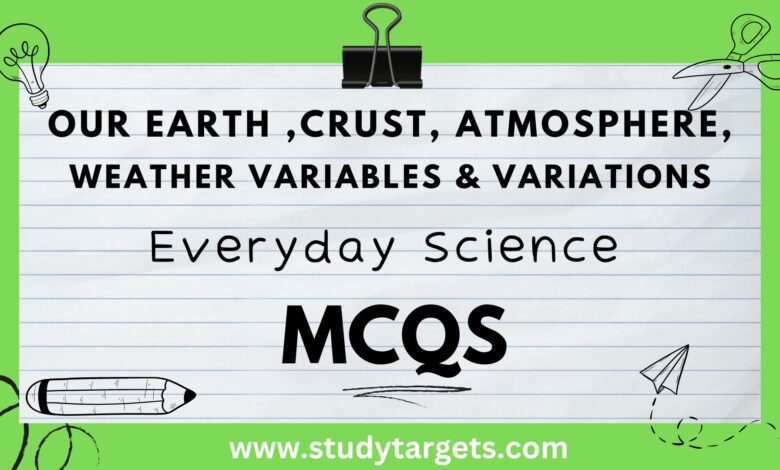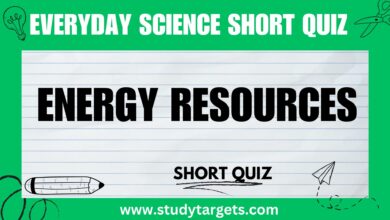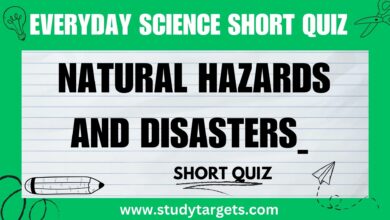MCQs: Our Earth ,Crust, Atmosphere,Weather variables & variations: Everyday Science MCQs:

Earth
1. Earth is the ____ planet from the Sun in our solar system.
a) First
b) Second
c) Third
d) Fourth
Answer: c) Third
2. What percentage of Earth’s surface is covered by water?
a) 25%
b) 50%
c) 75%
d) 97%
Answer: d) 97%
3. Which layer of Earth’s atmosphere contains the ozone layer?
a) Troposphere
b) Stratosphere
c) Mesosphere
d) Thermosphere
Answer: b) Stratosphere
4. The movement of Earth around the Sun is called:
a) Rotation
b) Revolution
c) Orbit
d) Tilt
Answer: b) Revolution
5. Earth’s outermost layer, upon which all life exists, is called the:
a) Mantle
b) Crust
c) Core
d) Lithosphere
Answer: b) Crust
6. The process by which plants convert carbon dioxide and sunlight into energy and oxygen is called:
a) Photosynthesis
b) Respiration
c) Combustion
d) Decomposition
Answer: a) Photosynthesis
7. What is the name of Earth’s natural satellite?
a) Mars
b) Jupiter
c) Luna (Moon)
d) Venus
Answer: c) Luna (Moon)
8. Earth’s magnetic field is primarily generated by the movement of molten iron and nickel in which layer?
a) Mantle
b) Crust
c) Core
d) Lithosphere
Answer: c) Core
9. Which imaginary line divides Earth into Northern and Southern Hemispheres?
a) Prime Meridian
b) Equator
c) Tropic of Cancer
d) Tropic of Capricorn
Answer: b) Equator
10. The process of breaking down rocks into smaller particles by natural forces is called:
a) Erosion
b) Deposition
c) Weathering
d) Sedimentation
Answer: c) Weathering
11. What is the primary source of energy that drives Earth’s climate and weather?
a) Tides
b) Volcanic activity
c) Solar radiation
d) Earth’s magnetic field
Answer: c) Solar radiation
12. Earth experiences four distinct seasons due to its:
a) Axis tilt
b) Shape
c) Distance from the Sun
d) Rotation speed
Answer: a) Axis tilt
13. The layer of Earth’s atmosphere where weather phenomena occur is called the:
a) Thermosphere
b) Exosphere
c) Troposphere
d) Ionosphere
Answer: c) Troposphere
14. The movement of Earth on its axis, causing day and night, is called:
a) Revolution
b) Rotation
c) Precession
d) Equinox
Answer: b) Rotation
15. Earth’s largest ocean is the:
a) Indian Ocean
b) Atlantic Ocean
c) Southern Ocean
d) Pacific Ocean
Answer: d) Pacific Ocean
16. The rocky, solid layer beneath Earth’s crust is called the:
a) Mantle
b) Lithosphere
c) Asthenosphere
d) Outer core
Answer: a) Mantle
17. What is the name of the densest layer of Earth’s atmosphere, closest to the surface?
a) Stratosphere
b) Mesosphere
c) Troposphere
d) Thermosphere
Answer: c) Troposphere
18. The movement of tectonic plates is responsible for the formation of:
a) Volcanoes and earthquakes
b) Mountains and glaciers
c) Oceans and lakes
d) Deserts and canyons
Answer: a) Volcanoes and earthquakes
19. The large circular currents in the Earth’s oceans caused by the Coriolis effect are called:
a) Tides
b) Gyres
c) Tsunamis
d) Storm surges
Answer: b) Gyres
20. What is the name of the layer of loose soil and rock fragments covering the bedrock on Earth’s surface?
a) Mantle
b) Crust
c) Soil profile
d) Regolith
Answer: d) Regolith
Our Earth’s Crust:
1. What is the outermost layer of the Earth called?
a) Mantle
b) Outer core
c) Crust
d) Inner core
Answer: c) Crust
2. The Earth’s crust is composed mainly of which two chemical elements?
a) Oxygen and carbon
b) Silicon and magnesium
c) Iron and nickel
d) Hydrogen and helium
Answer: b) Silicon and magnesium
3. Which type of rock is formed from the cooling and solidification of magma or lava?
a) Sedimentary rock
b) Metamorphic rock
c) Igneous rock
d) Fossilized rock
Answer: c) Igneous rock
4. What is the process by which rocks are broken down into smaller particles through natural processes like weathering?
a) Metamorphism
b) Deposition
c) Erosion
d) Compaction
Answer: c) Erosion
5. The boundary between the Earth’s crust and the underlying mantle is called:
a) Asthenosphere
b) Lithosphere
c) Mohorovičić discontinuity (Moho)
d) Convergent boundary
Answer: c) Mohorovičić discontinuity (Moho)
6. The process of one tectonic plate sliding beneath another is known as:
a) Divergence
b) Convergence
c) Subduction
d) Transform faulting
Answer: c) Subduction
7. Which type of rock is formed from pre-existing rocks that undergo changes due to heat and pressure?
a) Sedimentary rock
b) Igneous rock
c) Fossilized rock
d) Metamorphic rock
Answer: d) Metamorphic rock
8. The process by which sediments are pressed and cemented together to form solid rock is called:
a) Weathering
b) Erosion
c) Compaction
d) Subduction
Answer: c) Compaction
9. Which layer of the Earth’s crust is located beneath the ocean basins and is denser and thinner than continental crust?
a) Oceanic crust
b) Continental crust
c) Subduction crust
d) Volcanic crust
Answer: a) Oceanic crust
10. What type of rocks are formed from the accumulation of sediments over time?
a) Igneous rocks
b) Metamorphic rocks
c) Sedimentary rocks
d) Fossilized rocks
Answer: c) Sedimentary rocks
11. The theory of plate tectonics explains the movement of the Earth’s crust through the interaction of:
a) Magnetic fields
b) Ocean currents
c) Tidal forces
d) Tectonic plates
Answer: d) Tectonic plates
12. The point on the Earth’s surface directly above the origin of an earthquake is called the:
a) Focus
b) Epicenter
c) Rift
d) Plate boundary
Answer: b) Epicenter
13. What are large fractures in the Earth’s crust along which movement has occurred?
a) Deltas
b) Fjords
c) Faults
d) Estuaries
Answer: c) Faults
14. The theory of continental drift was proposed by:
a) Alfred Wegener
b) Charles Darwin
c) Isaac Newton
d) Marie Curie
Answer: a) Alfred Wegener
15. Which type of rock is formed from the accumulation and compaction of plant and animal remains over millions of years?
a) Igneous rock
b) Metamorphic rock
c) Sedimentary rock
d) Fossilized rock
Answer: c) Sedimentary rock
16. The Earth’s lithosphere is divided into large pieces known as:
a) Rocks
b) Oceans
c) Continents
d) Tectonic plates
Answer: d) Tectonic plates
17. Which type of tectonic plate boundary is characterized by plates moving away from each other?
a) Convergent boundary
b) Divergent boundary
c) Transform boundary
d) Subduction zone
Answer: b) Divergent boundary
18. The Himalayas were formed as a result of the collision between which two tectonic plates?
a) Eurasian Plate and African Plate
b) South American Plate and Pacific Plate
c) North American Plate and Pacific Plate
d) Indian Plate and Eurasian Plate
Answer: d) Indian Plate and Eurasian Plate
19. The process by which sedimentary rocks are formed from small particles being compacted together is called:
a) Erosion
b) Weathering
c) Cementation
d) Subduction
Answer: c) Cementation
20. Which type of tectonic plate boundary is characterized by plates sliding past each other horizontally?
a) Convergent boundary
b) Divergent boundary
c) Transform boundary
d) Subduction zone
Answer: c) Transform boundary
Earth’s Atmosphere:
1. What is the Earth’s atmosphere primarily composed of?
a) Nitrogen and oxygen
b) Carbon dioxide and oxygen
c) Helium and hydrogen
d) Nitrogen and carbon dioxide
Answer: a) Nitrogen and oxygen
2. The layer of the Earth’s atmosphere closest to the Earth’s surface is called the:
a) Troposphere
b) Stratosphere
c) Mesosphere
d) Thermosphere
Answer: a) Troposphere
3. The ozone layer, which absorbs harmful ultraviolet radiation from the Sun, is located in the:
a) Troposphere
b) Stratosphere
c) Mesosphere
d) Thermosphere
Answer: b) Stratosphere
4. What is the approximate percentage of oxygen in the Earth’s atmosphere?
a) 21%
b) 50%
c) 78%
d) 99%
Answer: a) 21%
5. The layer of the Earth’s atmosphere that contains the ionosphere and is responsible for auroras and radio wave propagation is the:
a) Troposphere
b) Stratosphere
c) Mesosphere
d) Thermosphere
Answer: d) Thermosphere
6. What is the name of the boundary that separates the troposphere from the stratosphere?
a) Tropopause
b) Stratopause
c) Mesopause
d) Thermopause
Answer: a) Tropopause
7. The greenhouse effect is caused by the trapping of heat in the Earth’s atmosphere by:
a) Oxygen
b) Carbon dioxide and water vapor
c) Nitrogen
d) Ozone
Answer: b) Carbon dioxide and water vapor
8. The layer of the Earth’s atmosphere that contains the ozone layer and is important for absorbing harmful ultraviolet radiation is the:
a) Troposphere
b) Stratosphere
c) Mesosphere
d) Thermosphere
Answer: b) Stratosphere
9. What is the outermost layer of the Earth’s atmosphere, where gases transition into outer space?
a) Troposphere
b) Exosphere
c) Mesosphere
d) Thermosphere
Answer: b) Exosphere
10. The layer of the Earth’s atmosphere that contains the coldest temperatures and is where meteors burn up upon entry is the:
a) Troposphere
b) Stratosphere
c) Mesosphere
d) Thermosphere
Answer: c) Mesosphere
Weather Variables & Variations:
1. What is the instrument used to measure atmospheric pressure?
a) Anemometer
b) Barometer
c) Hygrometer
d) Thermometer
Answer: b) Barometer
2. Humidity is a measure of:
a) Air pressure
b) Wind speed
c) Moisture content in the air
d) Temperature
Answer: c) Moisture content in the air
3. The amount of water vapor present in the air compared to the maximum amount the air could hold at that temperature is called:
a) Absolute humidity
b) Relative humidity
c) Dew point
d) Specific humidity
Answer: b) Relative humidity
4. Which weather variable is measured in units of Celsius or Fahrenheit?
a) Humidity
b) Pressure
c) Wind speed
d) Temperature
Answer: d) Temperature
5. The amount of rain or snowfall in a specific area during a specific time is known as:
a) Wind speed
b) Humidity
c) Precipitation
d) Barometric pressure
Answer: c) Precipitation
6. What is the instrument used to measure wind direction?
a) Barometer
b) Hygrometer
c) Rain gauge
d) Wind vane
Answer: d) Wind vane
7. The heat index is a measure of:
a) Air pressure and humidity
b) Wind speed and temperature
c) Temperature and humidity
d) Rainfall and temperature
Answer: c) Temperature and humidity
8. What is the term for the amount of solar energy received by a specific area over a specific period?
a) Solar radiation
b) Insolation
c) Solar wind
d) Solar luminosity
Answer: b) Insolation
9. Which weather variable is measured in units of millibars or inches of mercury?
a) Humidity
b) Temperature
c) Wind speed
d) Pressure
Answer: d) Pressure
10. The combination of wind speed and direction is called:
a) Pressure gradient
b) Isobars
c) Windchill
d) Wind vector
Answer: d) Wind vector
11. What is the term for the daily fluctuation in temperature, where temperatures are typically cooler at night and warmer during the day?
a) Heat wave
b) Temperature inversion
c) Diurnal temperature variation
d) Polar vortex
Answer: c) Diurnal temperature variation
12. What atmospheric condition is associated with a sudden drop in temperature and the formation of frost?
a) Heat wave
b) Temperature inversion
c) Dew point
d) Cold front
Answer: d) Cold front
13. The “wind chill factor” is a measure of:
a) How windy it feels outside compared to the actual air temperature
b) The speed of a cold front moving through an area
c) The strength of high-pressure systems
d) The amount of snowfall during a winter storm
Answer: a) How windy it feels outside compared to the actual air temperature
14. What weather phenomenon occurs when warm, moist air rises over a cold air mass, leading to cloud formation and precipitation?
a) Heat wave
b) Temperature inversion
c) Frontal boundary
d) Occluded front
Answer: c) Frontal boundary
15. The “heat index” is a measure of:
a) How hot it feels outside due to high humidity
b) The strength of a high-pressure system
c) The rate of temperature increase during a heat wave
d) The amount of solar radiation received during the day
Answer: a) How hot it feels outside due to high humidity
16. Which weather variation is characterized by a prolonged period of significantly below-average temperatures?
a) Heat wave
b) Polar vortex
c) Temperature inversion
d) El Niño
Answer: b) Polar vortex
17. What is the name for the periodic warming of sea-surface temperatures in the central and eastern Pacific Ocean, affecting global weather patterns?
a) Heat wave
b) Polar vortex
c) Temperature inversion
d) El Niño
Answer: d) El Niño
18. The “dew point” is the temperature at which:
a) Water vapor condenses into clouds
b) The atmosphere becomes completely saturated with water vapor
c) Frost forms on the ground
d) The air pressure drops significantly
Answer: b) The atmosphere becomes completely saturated with water vapor
19. What weather variation is characterized by a prolonged period of excessively hot and often humid conditions?
a) Cold wave
b) Temperature inversion
c) Heat wave
d) El Niño
Answer: c) Heat wave
20. What is the term for the atmospheric condition where a layer of warm air traps cooler air near the surface, preventing vertical mixing and potentially trapping pollutants?
a) Temperature inversion
b) Wind chill
c) Heat wave
d) Polar vortex
Answer: a) Temperature inversion




